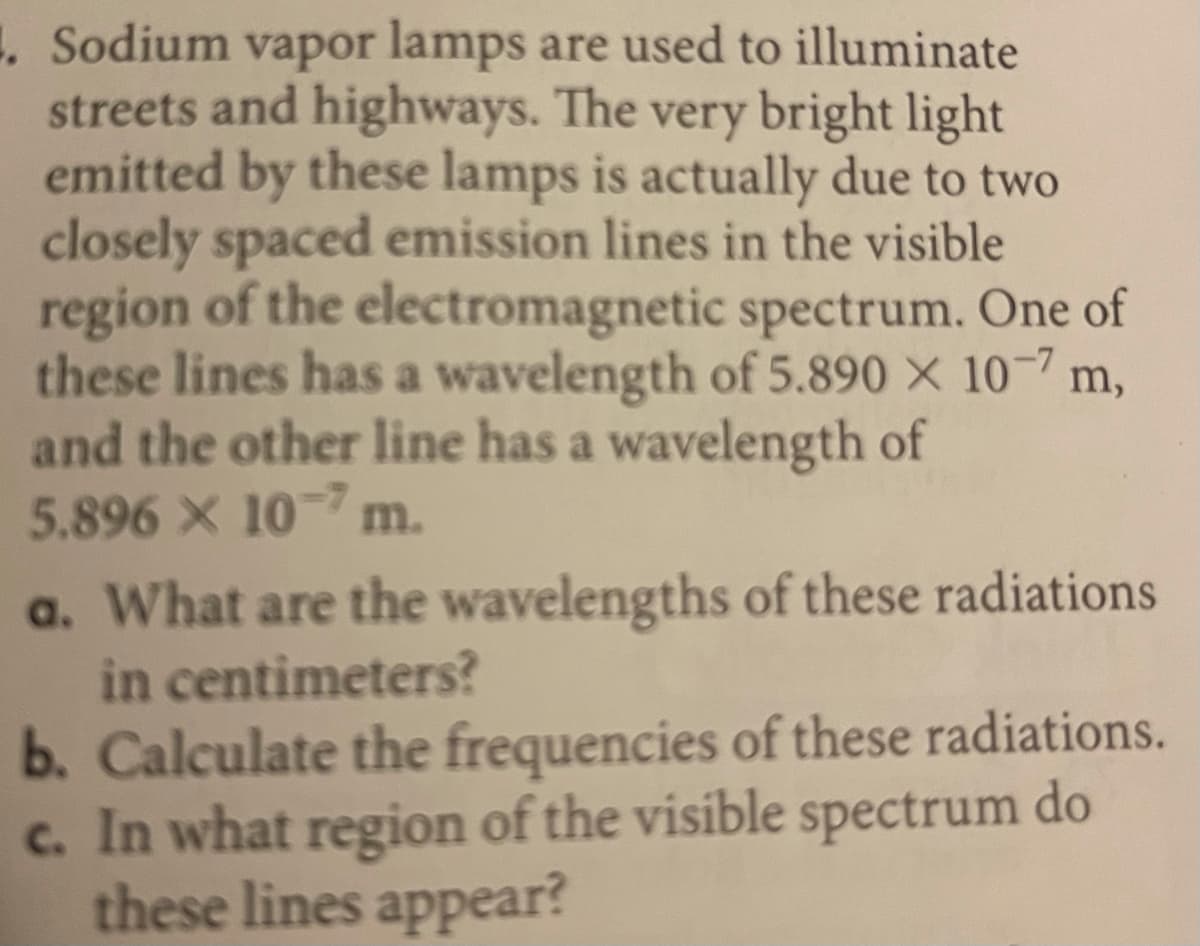Sodium vapor lamps are used to illuminate streets and highways. The very bright light emitted by these lamps is actually due to two closely spaced emission lines in the visible region of the electromagnetic spectrum. One of these lines has a wavelength of 5.890 X 10-7 m, and the other line has a wavelength of 5.896 X 10 m. a. What are the wavelengths of these radiations in centimeters? b. Calculate the frequencies of these radiations. c. In what region of the visible spectrum do these lines appear?
Sodium vapor lamps are used to illuminate streets and highways. The very bright light emitted by these lamps is actually due to two closely spaced emission lines in the visible region of the electromagnetic spectrum. One of these lines has a wavelength of 5.890 X 10-7 m, and the other line has a wavelength of 5.896 X 10 m. a. What are the wavelengths of these radiations in centimeters? b. Calculate the frequencies of these radiations. c. In what region of the visible spectrum do these lines appear?
Chemistry & Chemical Reactivity
9th Edition
ISBN:9781133949640
Author:John C. Kotz, Paul M. Treichel, John Townsend, David Treichel
Publisher:John C. Kotz, Paul M. Treichel, John Townsend, David Treichel
Chapter6: The Structure Of Atoms
Section: Chapter Questions
Problem 14PS: The most prominent line in the spectrum of neon is found at 865.438 nm. Other lines are located at...
Related questions
Question

Transcribed Image Text:1. Sodium vapor lamps are used to illuminate
streets and highways. The very bright light
emitted by these lamps is actually due to two
closely spaced emission lines in the visible
region of the electromagnetic spectrum. One of
these lines has a wavelength of 5.890 × 10-7 m,
and the other line has a wavelength of
5.896 X 10 m.
a. What are the wavelengths of these radiations
in centimeters?
b. Calculate the frequencies of these radiations.
c. In what region of the visible spectrum do
these lines appear?
Expert Solution
This question has been solved!
Explore an expertly crafted, step-by-step solution for a thorough understanding of key concepts.
This is a popular solution!
Trending now
This is a popular solution!
Step by step
Solved in 4 steps

Knowledge Booster
Learn more about
Need a deep-dive on the concept behind this application? Look no further. Learn more about this topic, chemistry and related others by exploring similar questions and additional content below.Recommended textbooks for you

Chemistry & Chemical Reactivity
Chemistry
ISBN:
9781133949640
Author:
John C. Kotz, Paul M. Treichel, John Townsend, David Treichel
Publisher:
Cengage Learning

Chemistry & Chemical Reactivity
Chemistry
ISBN:
9781337399074
Author:
John C. Kotz, Paul M. Treichel, John Townsend, David Treichel
Publisher:
Cengage Learning

Principles of Modern Chemistry
Chemistry
ISBN:
9781305079113
Author:
David W. Oxtoby, H. Pat Gillis, Laurie J. Butler
Publisher:
Cengage Learning

Chemistry & Chemical Reactivity
Chemistry
ISBN:
9781133949640
Author:
John C. Kotz, Paul M. Treichel, John Townsend, David Treichel
Publisher:
Cengage Learning

Chemistry & Chemical Reactivity
Chemistry
ISBN:
9781337399074
Author:
John C. Kotz, Paul M. Treichel, John Townsend, David Treichel
Publisher:
Cengage Learning

Principles of Modern Chemistry
Chemistry
ISBN:
9781305079113
Author:
David W. Oxtoby, H. Pat Gillis, Laurie J. Butler
Publisher:
Cengage Learning

Chemistry: An Atoms First Approach
Chemistry
ISBN:
9781305079243
Author:
Steven S. Zumdahl, Susan A. Zumdahl
Publisher:
Cengage Learning


Chemistry
Chemistry
ISBN:
9781305957404
Author:
Steven S. Zumdahl, Susan A. Zumdahl, Donald J. DeCoste
Publisher:
Cengage Learning